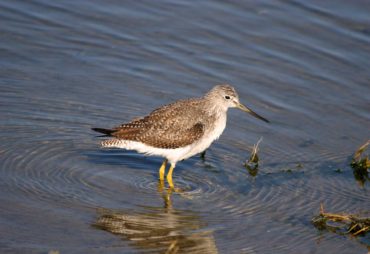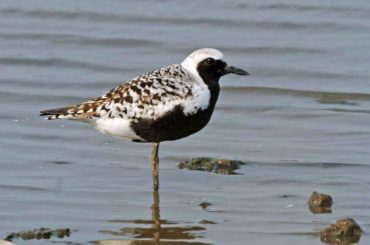
Webster’s Dictionary defines the term “estuary” as “what is commonly called a ‘wetland,’ as an inlet or arm of the sea; especially the lower portion or wide mouth of a river, where the salty tide meets the freshwater current.” Wetland is a popular way to describe this arrangement of nature. For decades, these wet and muddy places were only known as “mudflats.” Then more respect for the rich marine life that they support earned another title — tide flats or tidal flats. By whatever name, these places are food sources for millions of migrating birds.
The West Sound region is rich in estuaries. There may not be large rivers flowing into the bays, inlets and open waters of Puget Sound, but creeks abound throughout most of the area. Several creeks are responsible for creating estuaries. Their value as food sources for wild salmon runs is well known, but their importance for other marine life has also been recognized.
Shorebirds that migrate along the coast every spring have drawn attention to one of nature’s greatest spectacles. Bowerman Basin in Grays Harbor sees a concentration of shorebirds that runs in the millions every spring. They congregate in the area late March through April, drawing birdwatchers from all over the country. There is a spillover from this mass migration and it accounts for good birdwatching in West Sound estuarine areas.
Western sandpipers, black-bellied plovers, dowitchers, yellowlegs and killdeer are shorebird species seen on well-known, local tide flats. From Kingston to Poulsbo, Silverdale, Bremerton, Seabeck and Port Orchard southward, shorebirds headed for breeding grounds in the far north will pay a spring visit.
South of the Kingston Ferry Terminal, Carpenter Creek flows into the saltwater and creates a vast tidal marsh and an estuary that includes a roadside lagoon. When the tide is in, the saltwater pushes into the freshwater and deposits marine life the birds are drawn to.

The best viewing times for birds is on an incoming tide. The theory being that the advancing water brings the birds to the viewer. They not only feed as it approaches, they follow it on the way out as more mudflat is exposed.
Where Dogfish Creek enters Liberty Bay, the surrounding tide flats and saltwater shoreline host numerous shorebirds. It is also possible to take advantage of Fish Park’s viewing areas, which make it possible to explore farther into the creek and this estuary. Killdeer, semi-palmated plovers, yellowlegs and sandpipers visit this area and other accessible areas near the end of Liberty Bay.
Silverdale’s Clear Creek Estuary has been the scene of a major habitat restoration project for over a year. It is easy to see the birds because of the outstanding public access. Flocks of tiny Western sandpipers, both greater and lesser yellowlegs and other migrants are attracted to this estuary, located in one of the most vibrant business areas.
One of the most well-known estuarine areas in the West Sound includes the mudflats in Gorst. This giant tide land is created by several creeks flowing into Sinclair Inlet. Thousands of cars drive along and around this spot. There are always birds feeding here when the tide is low.
Gulls, ducks, shorebirds, great blue herons and even eagles rest and feed here. There is a challenge to shorebird identification but that doesn’t lessen the pleasure of seeing the different species as they move through this area.
Killdeer are well-known residents along our shorelines. In the spring, migrants add to their population. The familiar cry, “kill-deah, kill deah,” is often heard before the bird is seen.
There is another member of the plover family that looks almost identical to the killdeer. The semi-palmated plover closely resembles its cousin but is smaller and has only one dark ring around its neck.
Greater yellowlegs are another familiar shorebird both on inland shores and at the coast. They also have a small twin. The lesser yellowlegs is a good bird to expect where even small streams enter the saltwater.
If the two are feeding in the same area, they aren’t difficult to tell apart because the size difference is easy to see, especially if both are seen together. At 14 inches, the greater yellowlegs is much larger than the diminutive lesser at 10 inches. This bird is about the size of a killdeer.
Black-bellied plovers got their common name from their black undersides but this is only evident during the spring. Throughout the winter, these handsome birds have whitish undersides. By the time they are seen in the Northwest, their heads will still be light, but from the underside of their bill, over their face and down their chest and undersides, they will be black. Their backs are a scaly black and white. As with other shorebirds, both male and female look alike.
The restoring and enhancing of estuaries throughout the West Sound is making it possible for birdwatchers to see and enjoy the colorful spring migration even if a trip to the coast isn’t always possible.
























Comments